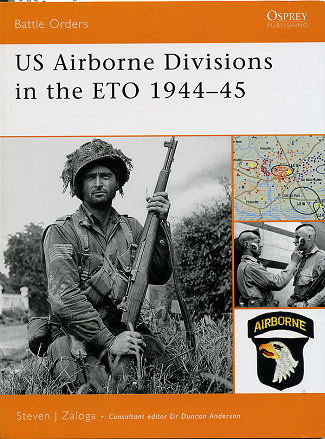 This
book adds to several recent titles on airborne units and troops, concentrating
on those operating in Europe during 1944-45. Basically from D-Day to the end of
the war.
This
book adds to several recent titles on airborne units and troops, concentrating
on those operating in Europe during 1944-45. Basically from D-Day to the end of
the war. |
Title: |
US Airborne Divisions in the ETO 1944-45 |
|
Editor: |
Steven J. Zaloga |
|
Publisher/Distributor |
Osprey Publishing |
|
Price |
$23.95 MSRP |
|
Reviewer: |
|
| Notes: |
96 pages, 7¼ x 9¼ inches, softcover ISBN: 978-1-84603-118-2 |
 This
book adds to several recent titles on airborne units and troops, concentrating
on those operating in Europe during 1944-45. Basically from D-Day to the end of
the war.
This
book adds to several recent titles on airborne units and troops, concentrating
on those operating in Europe during 1944-45. Basically from D-Day to the end of
the war.
To tell the story of these units, renowned author Steven J. Zaloga has been chosen. He has followed the normal route of the 'Battle Orders' series that starts with an introduction to airborne warfare, the mission of airborne units, the way these troops prepare for battle and the various unit organizations. Within airborne units are many of the same sections as in standard infantry division, though due to the need to bring in everything by air, equipment is more light weight and organizational levels are pared back to the essentials.
This leads on to a section on the weapons and equipment of airborne units, the way they are controlled during battles and the tactics used. Since these were new ways of fighting the war, each operation was something of a test. The four major drops of the European war; Operations Neptune, Dragoon, Market and Varsity are covered in some detail. Lessons learned are also discussed. One was that these airborne units were supposed to be pulled out of battle as soon as possible. Well, that just didn't work and often they were confronting the enemy for weeks on end. Another is that glider pilots were not trained in infantry tactics and became something of a burden on the units. Yet another is that gliders were basically one use vehicles when it was thought they could be used over and over. In the end, it brought an end to glider ops and the move to remove paratroops as a specialty and so train airborne units more like standard infantry, only giving them specialize equipment if they were to be used during air operations.
Helo Airmobile ops effectively have put a halt to even those things with the ability to bring in standard troops into battle. The book ends on the status of those Airborne infantry divisions today, where basically only the 82nd and 101st are still extant, though not as specialized airborne units in the WWII way of things.
A very well done book that provides a lot of insight into the hows and whys of WWII airborne operations. One of much interest and one that I can recommend to you without reservation.
June 2007
For more on the complete line of Osprey books, visit www.ospreypublishing.com. In the US, it is Osprey Direct at 44-02 23rd St, Suite 219, Long Island City, NY 11101., where you can get a catalogue of available books.
If you would like your product reviewed fairly and quickly by a site that has over 350,000 visitors a month, please contact me or see other details in the Note to Contributors.